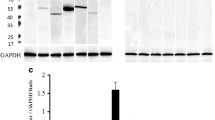Summary
In the pituitary gland of the cat, dopamine (M.V. 0.78 μg/g), noradrenaline (M.V. 0.29 μg/g) and 5-HT (M.V. 0.94 μg/g) have been found. With the histochemical fluorescence method, a rich system of delicate fluorescent varicose fibres, often provided with irregular swellings or droplets, was observed in the neural lobe and pars intermedia. Microspectrofluorimetrically, these fibre structures exhibit the spectral characteristics of catecholamines. Most cells in the pars intermedia and a large number of cells in pars distalis show a yellowish fluorescence, with microspectrofluorimetric characteristics which differ entirely from those of the catecholamines and 5-HT. In animals treated with reserpine, the pituitary dopamine, noradrenaline, and 5-HT are largely depleted. However, the intensity and the spectral properties of the cellular fluorescence are not affected by this treatment, whereas the fluorescent fibres can no longer be seen. Thus none — or only little — of the catecholamines and 5-HT but some other monoamine-like substance is stored in the fluorescent cells of the adenohypophysis. Preliminary studies suggest that this substance is closely related to or perhaps identical with tryptamine.
Similar content being viewed by others
References
Andén, N.-E., and T. Magnusson: An improved method for the fluorimetric determination of 5-hydroxytryptamine in tissues. Acta physiol. scand. 69, 87–94 (1967).
Bargmann, W., E. Lindner u. K. H. Andres: Über Synapsen an endokrinen Epithelzellen und die Definition sekretorischer Neurone. Untersuchungen am Zwischenlappen der Katzenhypophyse. Z. Zellforsch. 77, 282–292 (1967).
Bertler, Å.: Effect of reserpine on the storage of catecholamines in brain and other tissues. Acta physiol. scand. 51, 75–83 (1961).
—, A. Carlsson, E. Rosengren, and B. Waldeck: A method for the fluorimetric determination of adrenaline, noradrenaline and dopamine in tissues. Kgl. Fysiogr. Sällsk. Lund Förh. 28, 121–123 (1958).
Björklund, A.: Monoamine-containing fibres in the neuro-intermediate lobe of the pig and rat. Z. Zellforsch. 89, 573–589 (1968).
—, B. Ehinger, and B. Falck: A method for differentiating dopamine from noradrenaline in tissue sections by microspectrofluorometry. J. Histochem. Cytochem. 16, 263–270 (1968a).
—, A. Enemar, and B. Falck: Monoamines in the hypothalamo-hypophysial system of the mouse with special reference to the ontogenetic aspect. Z. Zellforach. 89, 590–607 (1968b).
-, and B. Falck: An improvement of the histochemical fluorescence method for monoamines. Observations on varying extractability of fluorophores in different nerve fibres. J. Histochem. Cytochem. (in press).
- -, and R. Håkansson: A histochemical fluorescence method for the improved demonstration of tryptamine. Microspectrofluorimetric characterization of the formaldehydeinduced fluorophores of tryptamine and other indolamines in models. To be published (1968c).
—, and E. Rosengren: Monoamines in the pituitary gland of the pig. Life Sci. 6, 2103–2110 (1967).
Caspersson, T., N.-Å. Hillarp, and M. Ritzén: Fluorescence microspectrophotometry of cellular catecholamines and 5-hydroxytryptamine. Exp. Cell Res. 42, 415 (1966).
Corrodi, H., u. N.-Å. Hillarp: Fluoreszenzmethoden zur histochemischen Sichtbarmachung von Monoaminen. 1. Identifizierung der fluoreszierenden Produkte aus Modellversuchen mit 6,7-Dimethoxyisochinolinderivaten und Formaldehyd. Helv. chim. Acta 46, 2425–2430 (1963).
—: Fluoreszenzmethoden zur histochemischen Sichtbarmachung von Monoaminen. 2. Identifizierung des fluoreszierenden Produktes aus Dopamin und Formaldehyd. Helv. chim. Acta 47, 911–918 (1964).
—, and G. Jonsson: The formaldehyde fluorescence method for the histochemical demonstration of biogenic monoamines. A review on the methodology. J. Histochem. Cytochem. 15, 65–78 (1967).
—, and T. Malmfors: Factors affecting the quality and intensity of the fluorescence in the histochemical method for demonstration of catecholamines. Acta histochem. (Jena) 25, 367–370 (1966).
Dahlström, A., and K. Fuxe: Monoamines and the pituitary gland. Acta endocr. (Kbh.) 51, 301–314 (1966).
Falck, B.: Observations on the possibilities of the cellular localization of monoamines by a fluorescence method. Acta physiol. scand. 56, Suppl. 197 (1962).
—, N.-Å. Hillarp, G. Thieme, and A. Torp: Fluorescence of catecholamines and related compounds condensed with formaldehyde. J. Histochem. Cytochem. 10, 348–354 (1962).
-, and Ch. Owman: A detailed methodological description of the fluorescence method for the cellular demonstration of biogenic monoamines. Acta Univ. Lund, Sect. II, No 7 (1965).
—: 5-Hydroxytryptamine and related amines in endocrine cell systems. Advanc. Pharmacol. 6, part A, 211–231 (1968).
Fuxe, K.: Evidence for the existence of monoamine neurons in the central nervous sytem. IV. Distribution of monoamine nerve terminals in the central nervous system. Acta physiol. scand. 64, Suppl. 247, 58 (1965).
Häggendal, J.: An improved method for fluorimetric determination of small amounts of adrenaline and noradrenaline in plasma and tissues. Acta physiol. scand. 59, 242–254 (1963).
Jonsson, G.: Fluorescence methods for the histochemical demonstration of monoamines. VII. Fluorescence studies on biogenic monoamines and related compounds condensed with formaldehyde. Histochemie 8, 288–296 (1967a).
—: Further studies on the specificity of the histochemical fluorescence method for the demonstration of catecholamines. Acta histochem. (Jena) 26, 379–390 (1967b).
Norberg, K.-A., M. Ritzén, and U. Ungerstedt: Histochemical studies on a special catecholamine-containing cell type in sympathetic ganglia. Acta physiol. scand. 67, 260–270 (1966).
Pearse, A. G. E., and M. M. Mcgregor: Functional cytology of the pituitary gland. Ann. Rep. Brit. Emp. Cancer Camp. 2, 665–666 (1964).
Ritzén, M.: Quantitative fluorescence microspectrophotometry of 5-hydroxytryptamineformaldehyde products in models and in mast cells. Exp. Cell Res. 45, 178–194 (1966).
Author information
Authors and Affiliations
Additional information
Supported by grants from the Swedish Medical Research Council (No B 68-12X-712-03 B and B 68-14X-56-04 B), the Association for the Aid of Crippled Children, New York, and by the Faculty of Medicine, University of Lund, Sweden.
Rights and permissions
About this article
Cite this article
Björklund, A., Falck, B. Pituitary monoamines of the cat with special reference to the presence of an unidentified monoamine-like substance in the adenohypophysis. Z. Zellforsch. 93, 254–264 (1968). https://doi.org/10.1007/BF00336693
Received:
Issue Date:
DOI: https://doi.org/10.1007/BF00336693



